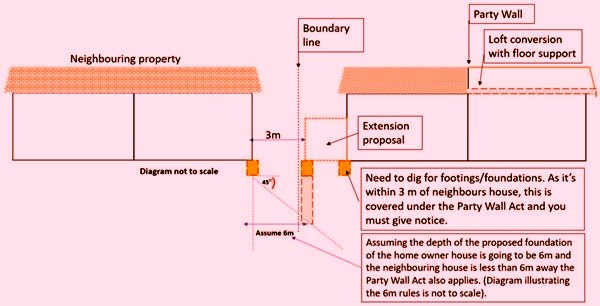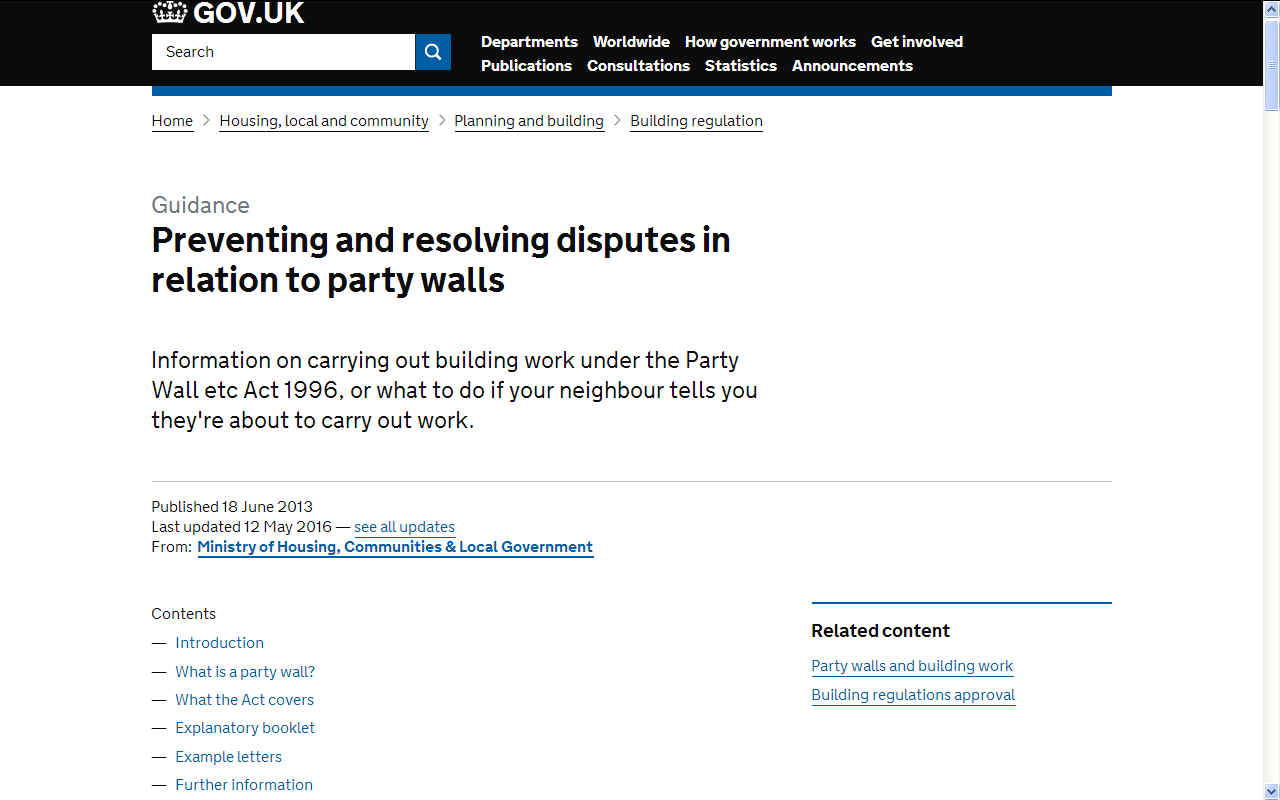|
PARTY WALL etc. ACT 1996
|
||||||||||||||||||||||||||||||||||||||||||||||||||||||||||||||||||||||||||||||||||||||||||||||||||||||||||||||||||||||||
|
The economy might still be struggling, but given the sheer number of builders’ vans parked outside houses up and down our
roads in 2018, one industry appears to be thriving. Wherever you look, there seems to be building work going on, and if you take a stroll down any one of our streets, with rows of terraced and semi detached houses dating from the early 20th century, you will not see many that have not been improved and extended.
The procedure is that the applicant needs to serve a written notice of their intention, and the neighbour then has 14 days to respond. Failure to do so is considered tacit objection, and that is where things can get expensive, as surveyors need to be appointed to protect the interests of each party and to adjudicate on the application.
Serving a party wall notice
The homeowner should take dated pictures of the party wall and ideally have agreed written notes of any cracks, with copies for both.
Or a surveyor could be appointed to assess and prepare a schedule of condition to minimise the risk of disputes later. This should be done shortly before the work starts.
The agreed surveyor should be independent and NOT the same surveyor the homeowner might be using for their own works. Otherwise their neighbour is unlikely to view the surveyor as neutral.
The Agreed Surveyor produces an “Award” which details the works proposed and a schedule of condition, including pictures, of the neighbour’s home.
Surveyors’ rates vary between £150.00 and £200.00 per hour. A party wall award and surveyor costs approximately £1000.00.
iii) Each owner appoints their own surveyor. However, this is expensive for the homeowner who is responsible for the costs of their neighbour’s surveyor as well as their own.
GRANNY - It's not always an aggressive developer who is acting to cause harm to a neighbouring property. June Townley was proud of her line of evergreens, tending them deliberately to cause loss of light to the premises next door, knowing that the roots would undermine the foundations. In an application by herself and her husband, Peter, the couple had applied jointly to build a granny annex, converting two garages, a potting shed and another outbuilding, part of an old courtyard comprising a former stable. In making the application there was no mention of the historic asset adjacent.
When this was brought to the attention of the County Archaeologist, conditions were applied to the consent that was granted, inasmuch as instructing a surveyor. There was also mention of the East Sussex Act, where the loss of two garages would have caused additional parking load for a shared driveway. Council's do not get involved in the Party Wall process itself, but can apply conditions where heritage concerns exist.
Due to the proximity and the height above the proposed development, underpinning is more than likely, such works causing significant risk, noise and discomfort to the occupiers of the old generating works.
The main aim of
the Party Wall Act is to avoid disputes and minimise risks, by making sure
that property owners formally tell their neighbours in advance (through
a ‘party wall notice’) about any proposed works and how the work will be carried out.
The
Act also includes garden walls built over a boundary and excavations close to a neighbour’s property (within three or six meters, depending on the depth of the new foundations).
Maintain good
relations with your neighbours
A shared cup of tea fosters good will and allays fears. It is an opportunity to show sketches and explain the planned works. It is worthwhile adding that a formal notice will be sent later.
It is reasonable for your neighbour to ask for the contact details of your surveyor and/or building company for further information and reassurance.
Common mistakes
iii) not using the standard, or wrong form of notice. The form of notice for excavating foundations is different from a party wall.
One building project may need more than one type of notice served on each affected neighbour.
CUT
OUT THE MIDDLE MAN - Going to a direct access barrister for legal advice and representation (without having to appoint a solicitor first) can mean enormous benefits for you in terms of time and cost-saving.
PARTY
WALL ACT 1996
EXAMPLE LAYOUT - In this diagram we see situations where the applicant will need to warn their neighbour about impending works.
ANTISOCIAL BEHAVIOUR - The legal height for a row of evergreens like this is two meters. You can see from the six foot fencing panel on the right that the height of these trees is more like fourteen feet. Russell Pike trimmed these trees to just over 12 feet in 2012. When asked why he had not cut them to the correct legal height, he replied that he thought twelve feet was the legal height under the Antisocial Behaviour Act 2003. If you check this out on any Government website you will see that it is 6 feet 6 inches or two meters. These trees are unlawful, they belonged to Peter and June Townley at the time of making application WD/2016/0809/F.
LINKS & REFERENCE
https://greatbaddow.org.uk/baddow-blog/local-councils-cannot-interfere-with-party-wall-disputes https://www.planningportal.co.uk/info/200187/your_responsibilities/40/other_permissions_you_may_require/16 http://www.legislation.gov.uk/ukpga/1996/40/contents https://hoa.org.uk/ https://www.gov.uk/guidance/party-wall-etc-act-1996-guidance
|
||||||||||||||||||||||||||||||||||||||||||||||||||||||||||||||||||||||||||||||||||||||||||||||||||||||||||||||||||||||||
FAIR USE NOTICE
This site contains copyrighted material the use of which has not always been specifically authorized by the copyright owner. We are making such material available in our efforts to advance understanding of environmental, political, human rights, economic, scientific, and social justice issues, etc. We believe this constitutes a 'fair use' of any such copyrighted material as provided for in section 107 of the US Copyright Law. In accordance with Title 17 U.S.C. Section 107, the material on this site is distributed without profit to those who have expressed a prior interest in receiving the included information for research and educational purposes. |
||||||||||||||||||||||||||||||||||||||||||||||||||||||||||||||||||||||||||||||||||||||||||||||||||||||||||||||||||||||||
|
This site is protected under Article10 of the European Convention on Human Rights and Fundamental Freedoms.
|





